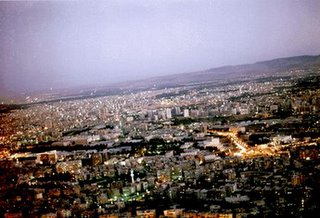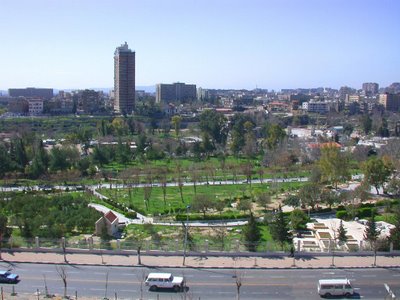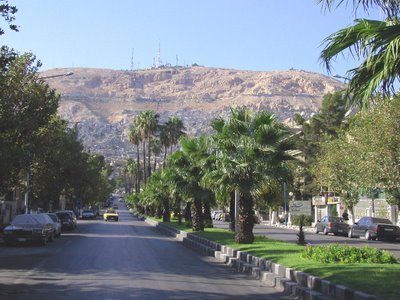Damascus skyline at night:

Damascus, the capital of Syria, is the oldest continuously inhabited city in the world. It has occupied a position of importance in the fields of science, culture, politics, art commerce, and industry from the earliest times. It has been called Al-Fayha'a (the fragrant city), Al-Sham, Jollaq, and Pearl of Orient as Emperor Julian named it. It was mentioned in the Holy Qur'an as the many-columns city of Aram, "whose like has never been built in the land".
Early references to Damascus such as those in Ebla tablets, confirm that it was as a city of immense economic influence during 3rd millennium BC.
Ancient Pharaonic scripts refers to it as Dameska. It enjoyed great prominence during 2nd millennium BC as center of an Aramaic kingdom under the name of Dar-Misiq (the irrigated house). The Aramites were the original inhabitants of Damascus, and their language was Syriac. Many villages around Damascus are still known by their Aramaic names.
Damascus fell under the domination of Greeks, Romans, and Byzantines. They all left their mark on Damascus as visitors can still readily observe today. In the Roman era, Damascus was first among ten most prominent cities. It received many privileges, especially during the reign of Syrian dynasty of Roman emperors. It was from Damascus that most talented architect of Roman Empire came. This was Apolodor the Damascene, who designed the celebrated Trajan Column in Rome, and the great bridge on the River Danube. Part of heritage of this era is the remains of the city-plan which Apolodor designed in oblong shape according with Roman architectural style. There is also part of the Roman temple of Jupiter, which was erected on the site of an older Aramaic temple (Hadad) where the Omayyad Mosque stands today; a part distinguished by its huge Corinthian columns with its richly decorated capitals.
In Byzantine era, a great number of churches and monasteries were built, and most of them have survived to present.
Damascus became capital of the first Arab state at time of the Omayyads in 661 AD. This marked the beginning of its golden epoch, and for a whole century it was the center of the youthful Islamic Empire. This reached its peak of expansion during this period, and came to stretch from shores of Atlantic and Pyrennese in west, to river Indus and China in east. Omayyads took a genuine interest in building up Damascus, organizing its souks (bazaars) and districts, improving its water supply, erecting palaces, and hospitals.
Nowadays, Damascus is a living museum spanning thousands of years. A city measuring time not by hours, days, months, and years but by empires it has seen rise and crumble to ruin.
Of the most important landmarks at Damascus are: Omayyad Mosque, Azem Palace, Damascus Citadel, Old Souks like Al-Hamidieyeh and Midhat Pasha, Bimarstan Al-Nory, Saladdin's Tomb, and Al-Tekiyeh Al-Sulaymaniyeh.
City Centre (The Central Bank of Syria is visible at the end of the road):
One of the more modern areas that had been developed in Damascus:
In this picture Mount Qassioun is visible in the background:


